Panthay Rebellion
| Panthay Rebellion | |||||||
|---|---|---|---|---|---|---|---|
| |||||||
| Belligerents | |||||||
|
|
| ||||||
| Commanders and leaders | |||||||
|
Cen Yuying Ma Rulong |
Du Wenxiu Ma Shenglin Ma Shilin | ||||||
| Strength | |||||||
| Manchu, Han Chinese, and Loyalist Muslim troops | Rebel Muslims, Rebel Han Chinese and Muslim ethnic minorities | ||||||
| Casualties and losses | |||||||
| 1,000,000 including Muslim and non-muslim civilians and soldiers | |||||||
The Panthay rebellion (1856–1873), known to Chinese as the Du Wenxiu Rebellion (Tu Wen-hsiu Rebellion; Chinese: 杜文秀起義; pinyin: Dù Wénxiù Qǐyì), was a rebellion of the Muslim Hui people and other (Muslim) ethnic minorities against the Manchu rulers of the Qing Dynasty in southwestern Yunnan Province, as part of a wave of Hui-led multi-ethnic unrest.
The name "Panthay" is a Burmese word, which is said to be identical with the Shan word Pang hse.[1] It was the name by which the Burmese called the Chinese Muslims who came with caravans to Burma from the Chinese province of Yunnan. The name was not used or known in Yunnan itself.[2]
Causes
.svg.png)
Discrimination by China's imperial administration against the Hui caused their rebellions.[3] Although some sources suggest that the Panthay Rebellion originated solely as a conflict between Han and Hui miners in 1853, Han-Hui tensions had existed for decades prior to the event including a three-day massacre of Hui by Han and Qing officials in 1845. Hui and Han were regarded and classified by Qing as two different ethnic groups, with Hui not regarded as an exclusively religious classification.
Volume 8 of the Encyclopedia of Religion and Ethics states that the Panthay Revolt by the Muslims was set off by racial antagonism and class warfare, rather than the mistaken assumption that it was all due to Islam and religion.[4]
In 1856, a massacre of Muslims organized by a Qing Manchu official responsible for suppressing the revolt in the provincial capital of Kunming sparked a province-wide multi-ethnic insurrgency.[5][6] In Dali City in western Yunnan, an independent kingdom was established by Du Wenxiu (1823–1872) who was born in Yongchang to a Han Chinese family, which had converted to Islam.[6][7]
Rebel ideology
The revolt was not religious in nature, since the Muslims were joined by non-Muslim Shan and Kakhyen and other hill tribes.[8] A British officer testified that the Muslims did not rebel for religious reasons, and that the Chinese were tolerant of different religions and were unlikely to have caused the revolt by interfering with the practising of Islam.[9] In addition, loyalist Muslim forces helped Qing crush the rebel Muslims.[10]
Du Wenxiu was not aiming his rebellion at Han, but was anti-Qing and wanted to destroy the Manchu government. During the revolt Hui from provinces which were not in rebellion, like Sichuan and Zhejiang, served as negotiators between rebel Hui and the Qing government. One of Du Wenxiu's banners said "Deprive the Manchu Qing of their Mandate to Rule" (革命滿清), and he called on Han to assist Hui to overthrow the Manchu regime and drive them out of China.[11][12] Du's forces led multiple non-Muslim forces, including Han Chinese, Li, Bai, and Hani.[13] Du Wenxiu also called for unity between Muslim Hui and Han. He was quoted as saying "our army has three tasks: to drive out the Manchus, unite with the Chinese, and drive out traitors."[14]
Du Wenxiu did not blame Han for the massacres of Hui, but blamed the tensions on the Manchu regime, saying that they were foreign to China and alienated the Chinese and other minorities.[15][16]
Du Wenxiu also called for the complete expulsion of Manchus from all of China in order for China to once again come under Chinese rule.[17]
Total war was waged against Manchu rule. Du Wenxiu refused to surrender, unlike the other rebel Muslim commander, Ma Rulong.[18] This may have had something to do with the sects of Islam practiced among the rebels. The Gedimu Hanafi Sunni Muslims under Ma Rulong readily defected to Qing, while the Jahriyya Sufi Muslims did not surrender. Some of the Jahriyya rebels in the Panthay Rebellion like Ma Shenglin were related to the Dungan revolt Jahriyya leader Ma Hualong and maintained contact with them.
The rebellion started after massacres of Hui perpetrated by the Manchu authorities.[19] Du used anti-Manchu rhetoric in his rebellion against the Qing, calling for Han to join the Hui to overthrow the Manchu Qing after 200 years of their rule.[20][21][22] Du invited the fellow Hui Muslim leader Ma Rulong to join him in driving the Manchu Qing out and "recover China".[23] For his war against Manchu "oppression", Du "became a Muslim hero", while Ma Rulong defected to the Qing.[24] On multiple occasions Kunming was attacked and sacked by Du Wenxiu's forces.[25][26] His capital was Dali.[27] The revolt ended in 1873.[28] Du Wenxiu is regarded as a hero by the present day government of China.[29]
Du Wenxiu wore Chinese clothing, and mandated the use of the Arabic language in his regime.[30][31] Du also banned pork.[32] Ma Rulong also banned pork in areas under his control after he surrendered and joined the Qing forces.[33]
In Kunming, there was a slaughter of 3,000 Muslims on the instigation of the judicial commissioner, who was a Manchu, in 1856. De Wenxiu was of Han Chinese origin despite being a Muslim and he led both Hui Muslims and Han Chinese in his civil and military bureaucracy. Du Wenxiu was fought against by another Muslim leader, the defector to the Qing Ma Rulong. The Muslim scholar Ma Dexin, who said that Neo-Confucianism was reconcilable with Islam, approved of Ma Rulong defecting to the Qing and he also assisted other Muslims in defecting.[34]
Tribal pagan animism, Confucianism, and Islam were all legalized and "honoured" with a "Chinese-style bureaucracy" in Du Wenxiu's Sultanate. A third of the Sultanate's military posts were filled with Han Chinese, who also filled the majority of civil posts.[35]
Revolution slogans of Du Wenxiu
|
| |||||||||
|
| |||||||||
Negotiations
Peace negotiations were held by Zhejiang and Sichuan Hui Muslims who were invited by the Qing to Yunnan in 1858 and they were not involved in the revolt.[38]
Course of the war
| Part of a series on:
Islam in China | ||||||
|---|---|---|---|---|---|---|
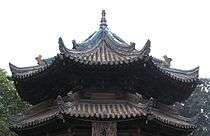 | ||||||
|
||||||
|
| ||||||
The rebellion started as widespread local uprisings in virtually every region of the province. It was the rebels in western Yunnan under the leadership of Du Wenxiu who, by gaining control of Dali in 1856 (which they retained until its fall in 1872), became the major military and political center of opposition to the Qing government. They turned their fury on the local mandarins and ended up challenging the central government in Beijing.
The Imperial government was handicapped by a profusion of problems in various parts of the sprawling empire, the Taiping rebellion being one of them. It was a time when China was still suffering from the shocks caused by the first series of unequal treaties, such as the Treaty of Nanking. These circumstances favored the ascendancy of the Muslims in Yunnan.
The Pacified Southern Kingdom
The rebels captured the city of Dali, which became the base for their operations, and they declared themselves a separate political entity from China. The rebels identified their nation as Pingnan Guo (Ping-nan Kuo; Chinese: 平南国; literally: "Pacified Southern State"); their leader Sulayman ibn `Abd ar-Rahman, known as Du Wenxiu [originally Yang Xiu (杨秀)[39]] (died 1873) was styled Qa´id Jami al-Muslimin ('Leader of the Community of Muslims', but usually referred to in foreign sources as Sultan) and ruled 1856 – 26 December 1872.
Governorships of the sultanate were also created in a few important cities, such as Momein (Tengyue), which were not far from the Burmese border town of Bhamo. The sultanate reached the high-water mark of its power and glory in 1860.
The eight years from 1860-68 were the heyday of the Sultanate. The Yunnanese Muslim rebels had either taken or destroyed 40 towns and 100 villages.[40]
Various rebel forces besieged the city of Kunming repeatedly: in 1857, 1861, 1863 and 1868. Ma Rulong, a Hui rebel leader from southern Yunnan, besieged the city in 1862, but he defected to the central government's forces after being offered a military post. His decision to quit the siege was not accepted by his followers, who took the opportunity of his absence to kill the Governor-General (Pan Duo) and to wrest control of the city from the Qing in 1863, with the intention of handing the city over to Du Wenxiu. However, before Du's forces could arrive, Ma Rulong—with the assistance of a rising Qing military officer, Cen Yuying—raced back to Kunming and regained control of the provincial capital.
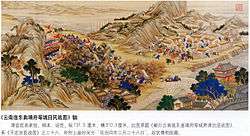
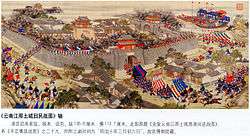

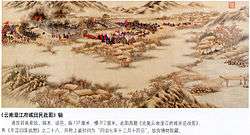
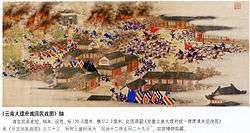
Decline
The Sultanate's power declined after 1868. The Chinese Imperial government had succeeded in reinvigorating itself. By 1871 it was directing a campaign for the annihilation of the obdurate Hui Muslims of Yunnan. By degrees the Imperial government had tightened the cordon around the Sultanate. The Sultanate proved unstable as soon as the Imperial government made a regular and determined attack on it. Town after town fell under well-organized attacks from imperial troops. Dali itself was besieged by imperial forces. Sultan Sulayman (also spelt Suleiman) found himself caged in by the walls of his capital. Desperately looking for outside help, he turned to the British for military assistance.[41] He realized that only British military intervention could have saved his Sultanate.
The Sultan had reasons for turning to the British. British authorities in India and British Burma had sent a mission led by Maj. Sladen to the town of Tengyue in present-day Yunnan (known as Momien in the Shan language) from May–July 1868.[42] The Sladen mission had stayed seven weeks at Momien meeting with rebel officials. The main purpose of the mission was to revive the Ambassadorial Route between Bhamo and Yunnan and resuscitate border trade, which had almost ceased since 1855, mainly because of the Yunnan Muslims' rebellion.
Taking advantage of the friendly relations resulting from Sladen's visit, Sultan Sulayman, in his fight for the survival of the Pingnan Guo Sultanate, turned to the British Empire for formal recognition and military assistance. In 1872 he sent his adopted son Prince Hassan to England with a personal letter to Queen Victoria, via Burma, in an attempt to obtain official recognition of the Panthay Empire as an independent power.[43] The Hassan Mission was accorded courtesy and hospitality in both British Burma and England. However, the British politely but firmly refused to intervene militarily in Yunnan against Peking.[41] In any case the mission came too late—while Hassan and his party were abroad, Dali was captured by Imperial troops in January 1873.
The Imperial government had waged an all-out war against the Sultanate with the help of French artillery experts.[41] The ill-equipped rebels with no allies were no match for their modern equipment, trained personnel and numerical superiority. Thus, within two decades of its rise, the power of the Panthays in Yunnan fell. Seeing no escape and no mercy from his relentless foe, Sultan Sulayman tried to take his own life before the fall of Dali. However, before the opium he drank took full effect, he was beheaded by his enemies.[44][45][46][47][48] Manchu troops then began a massacre of the rebels, killing thousands of civilians, sending severed ears along with the heads of their victims.[49] His body is entombed in Xiadui outside of Dali.[50] The Sultan's head was preserved in honey and dispatched to the Imperial Court in Peking as a trophy and a testimony to the decisive nature of the victory of the Imperial Manchu Qing over the Muslims of Yunnan.[51]
One of the Muslim generals, Ma Julung, defected to the Qing side.[52] He then helped the Qing forces crush his fellow Muslim rebels.[53][54][55] He was called Marshal Ma by Europeans and acquired almost total control of Yunnan province.[56] Ma Julung's name in modern Chinese pinyin is Ma Rulong.[57]
In the 1860s when Ma Rulong, in central and west Yunnan, fought to crush the rebel presence to bring the area under Qing control, a great-uncle of Ma Shaowu Ma Shenglin defended Greater Donggou against Ma Rulong’s army. Ma Shenglin was the religious head of the Jahriyya menhuan in Yunnan and a military leader. A mortar killed him during the battle in 1871.[57]
Scattered remnants of the Pingnan Guo troops continued their resistance after the fall of Dali, but when Momien was next besieged and stormed by imperial troops in May 1873, their resistance broke completely. Gov. Ta-sa-kon was captured and executed by order of the Imperial government.
Aftermath
Atrocities
Though largely forgotten, the bloody rebellion caused the deaths of up to a million people in Yunnan. Many adherents to the Yunnanese Muslim cause were persecuted by the imperial Manchus. Wholesale massacres of Yunnanese Muslims followed. Many fled with their families across the Burmese border and took refuge in the Wa State where, about 1875, they set up the exclusively Hui town of Panglong.[58]
For a period of perhaps ten to fifteen years following the collapse of the Panthay Rebellion, the province's Hui minority was widely discriminated against by the victorious Qing, especially in the western frontier districts contiguous with Burma. During these years the refugee Hui settled across the frontier within Burma gradually established themselves in their traditional callings – as merchants, caravaneers, miners, restaurateurs and (for those who chose or were forced to live beyond the law) as smugglers and mercenaries and became known in Burma as the Panthay.
At least 15 years after the collapse of the Panthay Rebellion, the original Panthay settlements in Burma had grown to include numbers of Shan and other hill peoples.
Impact on Muslims
The Qing dynasty did not massacre Muslims who surrendered, in fact, Muslim General Ma Rulong, who surrendered and join the Qing campaign to crush the rebel Muslims, was promoted, and among Yunnan's military officers serving the Qing, he was the strongest.[56][57]
The Qing armies left alone Muslims who did not revolt like in Yunnan's northeast prefecture of Zhaotong where there was a big Muslim population density after the war.[59]
The use of Muslims in the Qing armies against the revolt was noted by Yang Zengxin.[60]
The third reason is that at the time that Turkic Muslims were waging rebellion in the early years of the Guangxu reign, the ‘five elite divisions’ that governor general Liu Jintang led out of the Pass were all Dungan troops [Hui dui 回队]. Back then, Dungan military commanders such as Cui Wei and Hua Dacai were surrendered troops who had been redeployed. These are undoubtedly cases of pawns who went on to achieve great merit. When Cen Shuying was in charge of military affairs in Yunnan, the Muslim troops and generals that he used included many rebels, and it was because of them that the Muslim rebellion in Yunnan was pacified. These are examples to show that Muslim troops can be used effectively even while Muslim uprisings are still in progress. What is more, since the establishment of the Republic, Dungan have demonstrated not the slightest hint of errant behaviour to suggest that they may prove to be unreliable.
Impact on Burma
The rebellion had a significant negative impact on the Burmese Konbaung Dynasty. After losing lower Burma to the British, Burma lost access to vast tracts of rice-growing land. Not wishing to upset China, the Burmese kingdom agreed to refuse trade with the Pingnan Guo rebels in accordance with China's demands. Without the ability to import rice from China, Burma was forced to import rice from the British. In addition, the Burmese economy had relied heavily on cotton exports to China, and suddenly lost access to the vast Chinese market. Many surviving Hui refugees escaped over the border to neighboring countries, Burma, Thailand and Laos, forming the basis of a minority Chinese Hui population in those nations.
See also
- Panthay
- Islam in China
- Islam during the Qing Dynasty
- Yusuf Ma Dexin, a prominent Muslim scholar in Yunnan at the time of the rebellions
- Taiping Rebellion
- Nian Rebellion
- Miao Rebellion (1854–73)
- Nepalese-Tibetan War
- Dungan revolt (1862–1877)
- Punti–Hakka Clan Wars
References
 This article incorporates text from Burma past and present, by Albert Fytche, a publication from 1878 now in the public domain in the United States.
This article incorporates text from Burma past and present, by Albert Fytche, a publication from 1878 now in the public domain in the United States. This article incorporates text from Encyclopædia of religion and ethics, Volume 8, by James Hastings, John Alexander Selbie, Louis Herbert Gray, a publication from 1916 now in the public domain in the United States.
This article incorporates text from Encyclopædia of religion and ethics, Volume 8, by James Hastings, John Alexander Selbie, Louis Herbert Gray, a publication from 1916 now in the public domain in the United States.
- ↑ Scott 1900, p. 607
- ↑ Yule & Burnell 1968, p. 669
- ↑ Atwill 2005
- ↑ James Hastings; John Alexander Selbie; Louis Herbert Gray (1916). Encyclopædia of religion and ethics, Volume 8. EDINBURGH: T. & T. Clark. p. 893. Retrieved 2010-11-28.(Original from Harvard University)
- ↑ R. Keith Schoppa (2002). Revolution and its past: identities and change in modern Chinese history. Prentice Hall. p. 79. ISBN 0-13-022407-3. Retrieved 2010-06-28.
- 1 2 Fairbank, John King; Twitchett, Denis Crispin, eds. (1980). The Cambridge History of China. Cambridge University Press. p. 213. ISBN 0521220297. Retrieved 24 April 2014.
- ↑ Elleman, Bruce A. (2001). Modern Chinese Warfare, 1795-1989 (illustrated ed.). Psychology Press. p. 64. ISBN 0415214734. Retrieved 24 April 2014.
- ↑ Fytche 1878, p. 300
- ↑ Fytche 1878, p. 301
- ↑ Joseph Mitsuo Kitagawa (2002). The religious traditions of Asia: religion, history, and culture. Routledge. p. 283. ISBN 0-7007-1762-5. Retrieved 2010-06-28.
- ↑ Michael Dillon (1999). China's Muslim Hui community: migration, settlement and sects. Richmond: Curzon Press. p. 59. ISBN 0-7007-1026-4. Retrieved 2010-06-28.
- ↑ David G. Atwill (2005). The Chinese sultanate: Islam, ethnicity, and the Panthay Rebellion in southwest China, 1856-1873. Stanford University Press. p. 139. ISBN 0-8047-5159-5. Retrieved 2010-06-28.
- ↑ International Arts and Sciences Press, M.E. Sharpe, Inc (1997). Chinese studies in philosophy, Volume 28. M. E. Sharpe. p. 67. Retrieved 2010-06-28.
- ↑ Jean Chesneaux; Marianne Bastid; Marie-Claire Bergère (1976). China from the opium wars to the 1911 revolution. Pantheon Books. p. 114. ISBN 0-394-49213-7. Retrieved 2010-06-28.
- ↑ Association of Muslim Social Scientists, International Institute of Islamic Thought (2006). The American journal of Islamic social sciences, Volume 23, Issues 3-4. AJISS. p. 110. Retrieved 2010-06-28.
- ↑ Jacob Tyler Whittaker (1997). Du Wenxiu's Partial Peace: Framing Alternatives to Manchu Rule Across Ethnic Boundaries Among China's Nineteenth-century Rebel Movements. University of California, Berkeley. p. 38.
- ↑ David G. Atwill (2005). The Chinese sultanate: Islam, ethnicity, and the Panthay Rebellion in southwest China, 1856-1873. Stanford University Press. p. 120. ISBN 0-8047-5159-5. Retrieved 2010-06-28.
- ↑ Yunesuko Higashi Ajia Bunka Kenkyū Sentā (Tokyo, Japan) (1993). Asian research trends, Volumes 3-4. Centre for East Asian Cultural Studies. p. 137. Retrieved 2010-06-28.
- ↑ Schoppa, R. Keith (2008). East Asia: identities and change in the modern world, 1700-present (illustrated ed.). Pearson/Prentice Hall. p. 58. ISBN 0132431467. Retrieved 24 April 2014.
- ↑ Dillon, Michael (1999). China's Muslim Hui Community: Migration, Settlement and Sects. Curzon Press. p. 59. ISBN 0700710264. Retrieved 24 April 2014.
- ↑ Michael Dillon (16 December 2013). China's Muslim Hui Community: Migration, Settlement and Sects. Routledge. pp. 59–. ISBN 978-1-136-80933-0.
- ↑ Dillon, Michael (2012). China: A Modern History (reprint ed.). I.B.Tauris. p. 90. ISBN 1780763816. Retrieved 24 April 2014.
- ↑ Atwill, David G. (2005). The Chinese Sultanate: Islam, Ethnicity, and the Panthay Rebellion in Southwest China, 1856-1873 (illustrated ed.). Stanford University Press. p. 120. ISBN 0804751595. Retrieved 24 April 2014.
- ↑ Asian Research Trends, Volumes 3-4. Contributor Yunesuko Higashi Ajia Bunka Kenkyū Sentā (Tokyo, Japan). Centre for East Asian Cultural Studies. 1993. p. 137. Retrieved 24 April 2014. horizontal tab character in
|others=at position 12 (help) - ↑ Mansfield, Stephen (2007). China, Yunnan Province. Compiled by Martin Walters (illustrated ed.). Bradt Travel Guides. p. 69. ISBN 1841621692. Retrieved 24 April 2014. horizontal tab character in
|others=at position 12 (help) - ↑ China's Southwest. Regional Guide Series. Contributor Damian Harper (illustrated ed.). Lonely Planet. 2007. p. 223. ISBN 1741041856. Retrieved 24 April 2014. horizontal tab character in
|others=at position 12 (help) - ↑ Giersch, Charles Patterson (2006). Asian Borderlands: The Transformation of Qing China's Yunnan Frontier (illustrated ed.). Harvard University Press. p. 217. ISBN 0674021711. Retrieved 24 April 2014.
- ↑ Mosk, Carl (2011). Traps Embraced Or Escaped: Elites in the Economic Development of Modern Japan and China. World Scientific. p. 62. ISBN 9814287520. Retrieved 24 April 2014.
- ↑ Comparative Civilizations Review, Issues 32-34. 1995. p. 36. Retrieved 24 April 2014.
- ↑ Journal of Southeast Asian studies, Volume 16. McGraw-Hill Far Eastern Publishers. 1985. p. 117. Retrieved 2010-06-28.
- ↑ Journal of Southeast Asian studies, Volume 16. McGraw-Hill Far Eastern Publishers. 1985. p. 117. Retrieved 2010-06-28.
- ↑ Journal of Southeast Asian studies, Volume 16. McGraw-Hill Far Eastern Publishers. 1985. p. 127. Retrieved 2010-06-28.
- ↑ David G. Atwill (2005). The Chinese sultanate: Islam, ethnicity, and the Panthay Rebellion in southwest China, 1856-1873. Stanford University Press. p. 124. ISBN 0-8047-5159-5. Retrieved 2010-06-28.
- ↑ John King Fairbank (1978). The Cambridge History of China: Late Chʻing, 1800-1911, pt. 2. Cambridge University Press. pp. 213–. ISBN 978-0-521-22029-3.
- ↑ John King Fairbank (1978). The Cambridge History of China: Late Chʻing, 1800-1911, pt. 2. Cambridge University Press. pp. 214–. ISBN 978-0-521-22029-3.
- ↑ 王钟翰 2010
- ↑ 中国人民大学. 书报资料中心 (1984). 中国近代史, Issues 1-6. 中国人民大学书报资料社. p. 61. Retrieved 2010-06-28.
- ↑ Michael Dillon (1999). China's Muslim Hui Community: Migration, Settlement and Sects. Psychology Press. pp. 59–. ISBN 978-0-7007-1026-3.
- ↑ http://www.shijiemingren.com/doc-view-27181.html, retrieved 31 Mar 2017
- ↑ (Anderson, 1876, 343)
- 1 2 3 Thaung 1961, p. 481
- ↑ John Anderson; Edward Bosc Sladen; Horace Albert Browne (1876). Mandalay to Momien: A Narrative of the Two Expeditions to Western China of 1868 and 1875, Under Col. Edward B. Sladen and Col. Horace Browne. Macmillan and Company. p. 189.
- ↑ "The Chinese in Central Asia". Pall Mall Gazette. British Newspaper Archive. 19 December 1876. Retrieved 6 August 2014. (Subscription required (help)).
- ↑ Thant Myint-U. (2006). The River of Lost Footsteps: Histories of Burma. Macmillan. ISBN 0-374-16342-1. Retrieved 2010-06-28.
- ↑ Myint-U, Thant (2007). The River of Lost Footsteps: Histories of Burma. Macmillan. p. 145. ISBN 0374707901. Retrieved 24 April 2014.
- ↑ Myint-U, Thant (2012). Where China Meets India: Burma and the New Crossroads of Asia (illustrated, reprint ed.). Macmillan. ISBN 0374533520. Retrieved 24 April 2014.
- ↑ White, Matthew (2011). Atrocities: The 100 Deadliest Episodes in Human History (illustrated ed.). W. W. Norton & Company. p. 298. ISBN 0393081923. Retrieved 24 April 2014.
- ↑ Cooke, Tim, ed. (2010). The New Cultural Atlas of China. Contributor Marshall Cavendish Corporation. Marshall Cavendish. p. 38. ISBN 0761478752. Retrieved 24 April 2014. horizontal tab character in
|others=at position 12 (help) - ↑ Thant Myint-U. (2006). The River of Lost Footsteps: Histories of Burma. Macmillan. ISBN 0-374-16342-1. Retrieved 2010-06-28.
- ↑ Asian Research Trends, Volumes 3-4. Contributor Yunesuko Higashi Ajia Bunka Kenkyū Sentā (Tokyo, Japan). Centre for East Asian Cultural Studies. 1993. p. 136. Retrieved 24 April 2014. horizontal tab character in
|others=at position 12 (help) - ↑ Thaung 1961, p. 482
- ↑ de Kavanagh Boulger 1893, p. 319
- ↑ Davenport Northrop 1894, p. 130
- ↑ Littell & Littell 1900, p. 757
- ↑ Holmes Agnew & Hilliard Bidwell 1900, p. 620
- 1 2 de Kavanagh Boulger 1898, p. 443
- 1 2 3 Garnaut 2008
- ↑ Scott 1900, p. 740
- ↑ Dillon 1999, p. 77
- ↑ Garnaut, Anthony (2008), From Yunnan to Xinjiang:Governor Yang Zengxin and his Dungan Generals (PDF), Etudes orientales N°25, p. 104=105, retrieved 14 July 2010
Bibliography
- Atwill, David G. (2005), The Chinese Sultanate: Islam, Ethnicity and the Panthay Rebellion in Southwest China, 1856-1873, Stanford University Press, ISBN 0-8047-5159-5
- Davenport Northrop, Henry (1894), "The flowery kingdom and the land of the Mikado, or, China, Japan and Corea", Making of America Project, London, CA-ON: J.H.Moore Co. Inc., retrieved 28 June 2010
- Dillon, Michael (26 July 1999), China's Muslim Hui Community: Migration, Settlement and Sects, Richmond, UK: Routledge / Curzon Press, ISBN 0-7007-1026-4, retrieved 28 June 2010
- Fitzgerald, Charles Patrick (1996), Southern Expansion of the Chinese People: Southern Fields and Southern Ocean, Thailand: White Lotus Co., ISBN 974-8495-81-7
- Forbes, Andrew ; Henley, David (2011). Traders of the Golden Triangle. Chiang Mai: Cognoscenti Books. ASIN: B006GMID5K
- Fytche, Albert (1878), Burma past and present, LONDON: C. K. Paul & co., retrieved 28 June 20109=(Original from Harvard University)
- de Kavanagh Boulger, Demetrius Charles (1893), A Short History of China: Being an Account for the General Reader of an Ancient Empire and People, W. H. Allen & co., retrieved 28 June 2010
- de Kavanagh Boulger, Demetrius Charles (1898), The History of China, 2, W. Thacker & co., retrieved 28 June 2010
- Scott, J. George (1900), "i", GUBSS 1, Rangoon Government Printing
- Thant, Myint-U (2001), The Making of Modern Burma, Cambridge University Press, ISBN 978-0-521-78021-6
- Yule, Col. Henry; Burnell, A.C. (1968) [1886 (1st ed. Murray, London)], Hobson-Jobson: A Glossary of Colloquial Anglo-Indian Words and Phrases, and of Kindred Terms, Etymological, Historical, Geographical And Discursive, Munshiran Manoharlal (reprint)
Essays, studies
- Garnaut, Anthony (2008), From Yunnan to Xinjiang:Governor Yang Zengxin and his Dungan Generals (PDF), Etudes orientales N°25, retrieved 14 July 2010
Articles (in journals, magazines etc.)
- "Contemporary Review", Religious toleration in China, vol.86, July 1904
- Holmes Agnew, John; Hilliard Bidwell, Walter (1900), Eclectic Magazine, Leavitt, Throw and Co., retrieved 28 June 2010
- Littell, Eliakim; Littell, Robert S. (22 September 1900), "The Living Age", Making of America Project, The Living Age Co. Inc., vol.225 (issue 2933), retrieved 28 June 2010
- 王钟翰 (2010), 中国民族史 [Han Chinese National History], GWculture.net, retrieved 28 June 2010 (in simplified Chinese)
External links
| Wikimedia Commons has media related to Panthay Rebellion. |